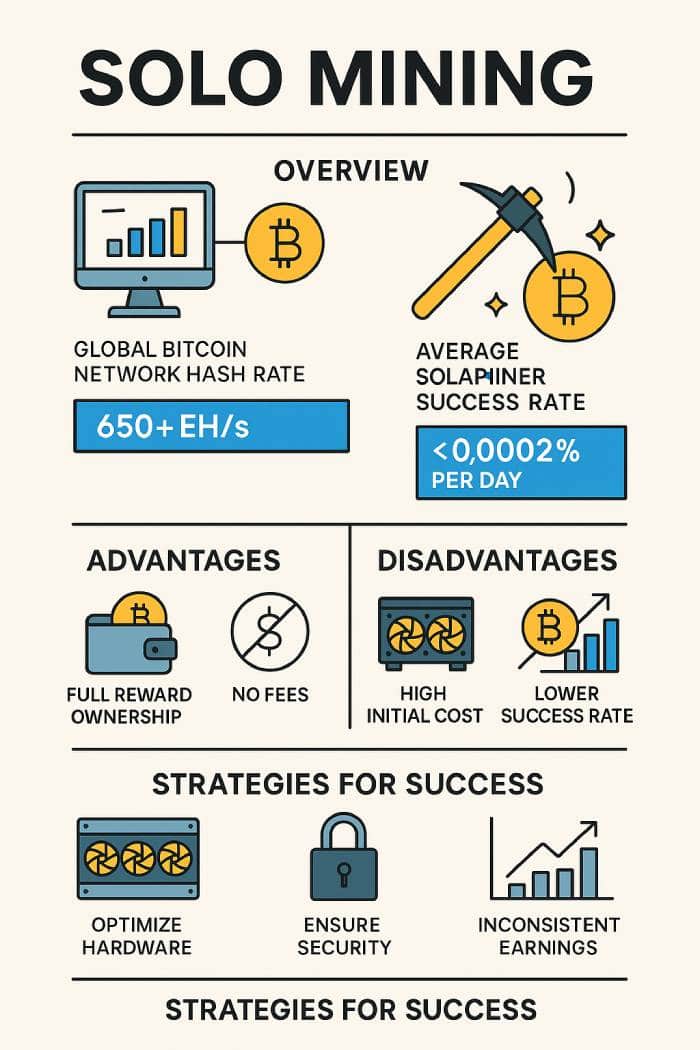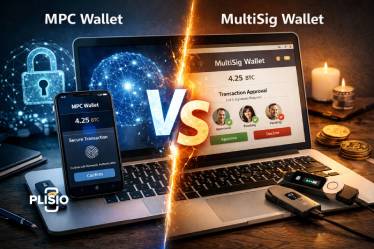Solo Mining: What It Is and How It Works

Solo mining is characterized by the solo miner independently handling the mining operations, depending solely on their mining hardware's hashing power and the bitcoin network's mining difficulty. Despite the high potential returns, this method demands considerable capital investment and patience, as achieving success can take years and is never guaranteed.
As of 2025, the global average hash rate of the Bitcoin network exceeds 650 EH/s (exahashes per second), making it increasingly challenging for solo miners to compete effectively without industrial-grade mining rigs. The probability of a solo miner with a mid-range ASIC device mining a block is estimated to be less than 0.0002% per day.
Solo miners often grapple with intense competition in solving hashes to mine a block, a challenge exacerbated by the relentless quest for superior hash rate within the mining community. This fierce competition poses significant hurdles for those attempting to mine solo.
However, solo mining does boast distinct advantages, such as retaining full ownership of the block reward and the possibility of higher long-term yields. Strategies to enhance solo mining success include optimizing mining hardware, ensuring robust security measures, and consistent performance monitoring.
Expert Insight:
Dr. Elena Martínez, blockchain analyst at CryptoTech Institute, notes, "Solo mining represents the purest form of blockchain participation. However, with current network conditions, it’s akin to playing the lottery — rewarding, but extremely rare. It’s ideal only for those with substantial infrastructure or experimental goals."
What is Solo Mining?
Solo mining, as the name suggests, involves a solo miner independently carrying out the mining operations without joining a mining pool or relying on any third parties. In this setup, miners connect their mining rigs directly to their native cryptocurrency wallet clients to discover and mine a block.
Solo miners who successfully mine a block within the network are rewarded significantly. As of the April 2024 Bitcoin halving, the block reward stands at 3.125 BTC plus transaction fees. The success of solo mining largely depends on the miner's hardware hash rate and the overall bitcoin network hash rate.
Historically, when mining difficulty was lower, solo miners could earn substantial profits. However, fluctuations in bitcoin value and high electricity costs—currently averaging $0.12–$0.15 per kWh in major mining regions—can significantly impact profitability.
The feasibility and profitability of solo mining hinge on two critical factors: the power of the mining hardware and the mining difficulty of the network. The outcome of solo mining can vary dramatically—bitcoin miners may solve the cryptographic challenges of block data quickly, or it could take years.
Expert Comment:
Jinwoo Park, an independent crypto researcher based in Seoul, adds, "Solo mining is not just about power, it’s about timing and persistence. In many cases, it’s also about luck. Miners must be aware of the increasing difficulty and electricity rates which change the game month to month."
Despite the challenges, solo mining can potentially offer higher returns over time compared to pool mining, due to the miner not having to share rewards with a mining pool. However, because finding blocks can be sporadic and challenging, many opt to join a mining pool, which provides more frequent but smaller rewards and involves collectively mining cryptocurrencies like Bitcoin or various altcoins.
For those considering to engage in solo mining, it is essential to possess significant hashing power to remain competitive. Additionally, the advent of FPGA (Field-Programmable Gate Array) technology has shifted the landscape from traditional CPU or GPU mining, offering more efficiency and power. Prospective solo miners should thoroughly research the potential expenses and earnings to gauge whether the endeavor is likely to be profitable. This approach is vital to navigate the complex dynamics of cryptocurrency mining successfully.
Expert Comment:
Lucas Reed, CTO of mining firm HexaHash, explains, "Solo mining appeals to miners seeking full autonomy. But unless you're running your own mining farm with cutting-edge ASICs, it’s more of an educational venture than a viable income source in 2025."
How is solo mining carried out?
Cryptocurrency mining involves solving complex cryptographic equations to mint new coins. Those who engage in this activity are referred to as miners. Miners require powerful computers and mining rigs capable of handling the intensive computational demands necessary to solve these equations.
The essence of crypto mining is the verification of blocks that contain transaction data, which are then added to a public ledger known as the blockchain. This ledger is secured through advanced encryption techniques, ensuring the integrity and security of the data stored within.
Mining operates within a decentralized network framework, where cryptographic algorithms independently verify transactions. This decentralized nature eliminates the need for a central authority to manage or control the system, thereby enhancing security and reducing potential points of failure.
As technology progresses, the mining process continues to evolve, incorporating more efficient computing solutions such as ASICs and GPUs, which are specifically designed to optimize the bitcoin mining operations. Additionally, environmental concerns and the increasing energy consumption—currently estimated at over 140 TWh annually for Bitcoin alone—have spurred the development of more sustainable mining practices and the exploration of renewable energy sources to power mining operations.
Expert Note:
Greta Singh, sustainability lead at Blockchain Earth, remarks, "As mining energy demands rise, solo miners must not only consider profitability, but also long-term access to renewable or low-cost power. Environmental regulations are tightening worldwide, and efficient energy use is no longer optional."
This comprehensive approach ensures that cryptocurrency mining not only supports the creation and distribution of digital currencies but also contributes to the ongoing development and security of the blockchain technology underlying these currencies.

What are the steps of solo mining?
In cryptocurrency mining, miners employ powerful computers and mining hardware to solve intricate numerical equations essential for verifying transactions involving crypto coins. The competitive nature of this field adds an intriguing layer to the process. Specifically, the first miner to successfully solve these complex equations earns the right to validate and authorize the transaction and receive the block reward.
For their efforts, miners receive rewards from the cryptocurrency community. These rewards, including transaction fees and BTC, serve as an incentive to encourage continuous participation and support for the network's security and operability. After miners complete the verification process, the newly validated data is added to the blockchain in the form of new blocks.
The blockchain itself acts as a decentralized ledger that records all transactions transparently and immutably. This decentralization ensures that no single entity has control over the entire network, which enhances security and trust. Over time, as more mining blocks are added, the blockchain grows and strengthens.
Additionally, the evolution of mining technology and strategies continues to influence the efficiency and environmental impact of these operations. Innovations such as the use of renewable energy sources and the development of more energy-efficient mining hardware are crucial in addressing the significant energy demands of mining activities. These advancements not only optimize the mining process but also align with global sustainability goals.
How does a beginner start mining on their own?
To begin bitcoin mining or mining other cryptocurrencies, you will need a high-performance computer capable of solving complex mathematical problems for extended periods. Additionally, setting up a digital wallet that supports popular cryptocurrencies such as Bitcoin (BTC), Ethereum (ETH), and others is essential for managing your mining rewards.
You have two main options for mining: join a mining pool or venture into solo mining. In a mining pool, multiple miners combine their computing power to enhance their collective mining capabilities and increase their chances of earning mining rewards.
The mining algorithm is utilized by various cryptocurrencies, including BTC, ETH, and Dogecoin (DOGE). This decentralized system ensures that no single authority can control the blockchain processes. Crypto mining is crucial for maintaining the cryptocurrency ecosystem on the blockchain, as it involves adding new blocks through a mechanism known as Proof of Work (PoW).
A new block is added to the bitcoin network approximately every ten minutes when a bitcoin miner successfully solves a cryptographic challenge, demonstrating a valid PoW. This PoW protocol is vital for preventing issues such as double-spending and the unauthorized creation of coins.
Within the cryptocurrency community, there are primarily two popular methods of mining: solo mining and pool mining. Solo mining allows miners to mine solo, keeping all the block rewards they earn but facing more significant challenges due to the need for substantial computational power and the variability of mining rewards. Pool mining, however, offers more consistent payouts by sharing rewards among a group, though it involves dividing the earnings.
For those new to mining, it is advisable to start with thorough research on the required mining hardware, such as ASICs (Application-Specific Integrated Circuits) or GPUs (Graphics Processing Units), and to understand the electricity costs associated with the energy-intensive process of mining. Additionally, staying informed about the latest mining software updates and blockchain technologies can significantly enhance the efficiency and profitability of your mining operations.
Key Components for Setting Up a Solo Mining Rig
Embarking on a solo mining journey demands a robust setup, starting with high-performance computing hardware that can handle complex mathematical problems. Originally, miners used CPUs; however, as mining difficulty increased and technology progressed, the shift moved towards more efficient mining hardware like GPUs, FPGAs, and ASICs, each offering superior processing power and efficiency.
Key Steps to Establish a Solo Mining Operation:
- Selecting the Optimal Cryptocurrency: Not all cryptocurrencies are equally viable for solo mining. It's important to consider aspects like mining difficulty, the current value of the coin, and the compatibility of your mining hardware when choosing which cryptocurrency to mine solo.
- Investing in the Right Mining Hardware: Based on the cryptocurrency you decide to mine, different hardware may be required. For instance, ASIC miners are typically used to mine bitcoin due to their efficiency, while powerful GPUs are better suited for mining various altcoins.
- Installing and Configuring Mining Software: Once you've selected and acquired your mining hardware, the next step is to install and set up the mining software. This software acts as the bridge connecting your mining rig to the cryptocurrency’s network, enabling you to begin the mining process.
- Ongoing Monitoring and Maintenance: To ensure the smooth running of your solo mining operations, it’s critical to continuously monitor both your mining rigs and the cryptocurrency network. Keeping your mining software and mining hardware updated, and making adjustments based on changes in mining difficulty and profitability metrics, are vital for sustaining optimal mining performance.
Embarking on solo mining is a significant endeavor that requires careful planning and continuous oversight, but with the right setup and strategies, it can also be a rewarding venture.
Advantages and Disadvantages of Solo Mining
Advantages:
- Full Ownership of Rewards: Solo miners keep the entire block reward and transaction fees. With the current reward at 3.125 BTC, this can be substantial.
- No Pool Fees: Since solo miners operate independently, they are not subject to mining pool fees that can range from 1% to 3%.
- Reduced Downtime: Solo mining setups are often more stable since they aren't affected by external pool connectivity issues.
- Operational Control: Miners maintain full control over their mining rigs, software configuration, and strategies.
- Potential for Long-Term Profitability: Without having to share earnings, successful solo miners may achieve higher cumulative returns over time.
Disadvantages:
- Low Probability of Success: As of 2025, the odds of solo mining a block with consumer-level hardware are extremely low due to high network hash rates.
- High Initial Investment: Effective solo mining requires industrial-grade ASICs and robust infrastructure, often costing thousands of dollars.
- Irregular Payouts: Solo mining can result in long periods without any rewards, creating financial uncertainty.
- Increased Risk: Without shared effort, solo miners bear all costs, including electricity and maintenance, without guaranteed income.
- Greater Technical Demands: Solo miners must handle all aspects of setup, security, monitoring, and maintenance themselves.
Expert Opinion:
Fatima El-Baz, crypto infrastructure consultant, says: "Solo mining is like running your own business — full freedom, full risk. Those who are deeply invested in the ecosystem and have a long-term mindset may find it rewarding. But casual miners should realistically consider joining a mining pool."
Solo mining is not for everyone, but for those with the right equipment, technical skills, and risk tolerance, it can offer autonomy and potential long-term rewards that pool mining can't match. Carefully weighing these pros and cons is crucial before deciding to mine solo.
Strategies for Successful Solo Mining
To thrive in solo mining, it's crucial to fine-tune your mining setup, enforce strong security measures, and consistently monitor and manage your operations. Here are detailed strategies to guide you in optimizing each of these key areas:
Maximizing Mining Setup Efficiency
- Select Appropriate Hardware: The foundation of effective solo mining lies in choosing high-performance ASICs or GPUs. These devices dramatically enhance your ability to efficiently solve cryptographic puzzles. Select hardware that is specifically suited to the cryptocurrency you aim to mine and its corresponding mining algorithm.
- Optimize Mining Software and Configuration: Choose mining software that is compatible with both your hardware and the target cryptocurrency. Adjusting your mining software settings to maximize performance can significantly boost your mining success.
- Stay Technologically Informed: The mining sector is rapidly evolving; keeping up-to-date with the latest hardware enhancements and software updates is essential for staying competitive in the field.
Implementing Robust Security Measures
- Secure Your Mining and Digital Wallets: Safeguard your mining setups and digital wallets with stringent security practices. This includes employing strong passwords, enabling two-factor authentication, and utilizing secure methods for wallet storage.
- Consistently Update Software: Regular updates to your mining software and security measures are crucial to defend against vulnerabilities and new threats.
Monitoring and Management Techniques
- Regular Performance Checks: Utilize mining software or external tools to monitor your rig’s performance metrics such as hash rate, temperature, and efficiency. Adjustments may be necessary to maintain optimal operation.
- Assess Profitability Continuously: Keep track of electricity costs, mining difficulty, and cryptocurrency market fluctuations to ensure your mining activities remain economically viable. Utilize online calculators and tools to project potential earnings and expenditures.
- Engage with Mining Communities: Joining mining forums and communities can be incredibly beneficial. These platforms provide a wealth of knowledge, offering advice, support, and insights from seasoned miners. They can help with troubleshooting, keep you informed on the latest mining trends, and potentially open up new mining opportunities.
Expert Tip:
Marco Thorsen, lead engineer at MinerLink, shares: "Solo mining success hinges on proactive management. Those who treat it like a hands-on operation — with live monitoring, system redundancy, and detailed cost tracking — are far more likely to turn a profit."
By methodically addressing these areas, you can enhance your chances of success in solo mining, making the most of your investment and efforts in the competitive field of cryptocurrency mining.




